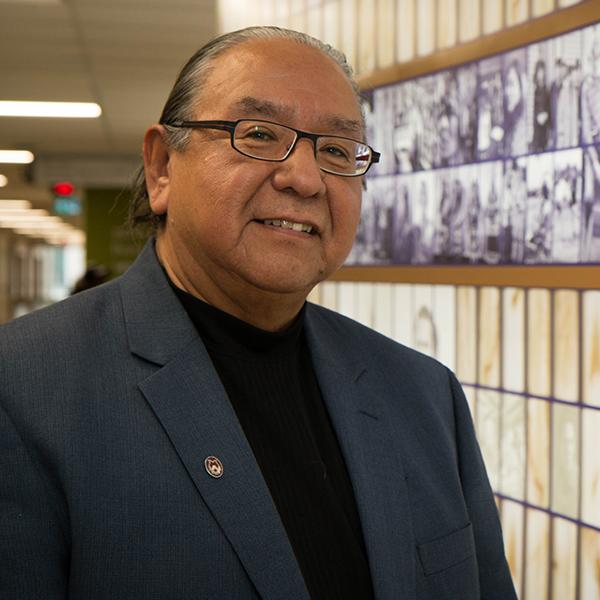
Alumni Spotlight

Alumni Spotlight
Amos Key Jr. has waited a generation to see the results of his life’s work.
In 1984, Key was ‘head hunted’ to leave the London Board of Education to join the Woodland Cultural Centre in Brantford to oversee the launch of Ontario’s first Indigenous immersive language program and eventually establish a board of education.
At Woodland, Key designed a program to educate generations of Six Nations people in their traditional Cayuga and Mohawk languages. The program’s goal was to help them become bilingual while revitalizing and stabilizing their traditional languages to prevent the languages from dying out. All of the program’s graduates received their Ontario Secondary School Diploma (OSSD).
Since Key’ program launched three decades ago similar programs have started up in communities and schools across Canada. Today First Nations language revitalization is a nation-wide movement.
“The last few years have been emotional for me,” said Key, Director of First Nations Languages at the Woodland Cultural Centre in Brantford. “The students who were in our first cohort and are now in their 30s are fully bilingual. For any teacher and educator that kind of success really touches you.”
For his work at The Centre, Key is now widely regarded as one of the main architects of the language revitalization movement among First Nations people in Ontario and Canada. In a small way, Mohawk can take some of the credit for his success. When he came to Mohawk to study in the Television and Communication Arts program in 1973, Key said he never gave much thought to what it meant to be First Nations.
“Being a Mohawk from Six Nations I never thought about what it was like to be an ‘Indian’ from Ontario,” said Key. “I would get those questions from my fellow students but I was so focused in and engrained with getting an education and I never paid much attention to my ancestry and about that side of my life.”
It was his classmates’ questions and curiosity about his background that put him on the path to becoming an educator, he says.
“I think their questions inspired me to learn more about myself and that was one of the reasons I became interested in community development.”
Key graduated from Mohawk in 1976. He credits his Mohawk education for helping him understand the power of communication and for instilling in him a desire for more education. He went on to study Photographic Arts at Toronto Metropolitan University and Sociology at the University of Western Ontario.
Although he has never worked directly in the media, there have been many times when he put the skills he learned at Mohawk to use. Early in his career, he used what he learned at Mohawk to help establish southern Ontario’s first native ‘community radio station’ on Six Nations that is still in operation today at, CKRZ 103 FM. The station was launched in 1990.
As its co-founder, Key volunteered for the community radio station as its chairman for the first 20 years. During the same time period, he also produced a weekly Blues Radio Show ‘The Real Blues Hours’ with his niece, Diane Keye, who is also an Alumni of Mohawk.
In 2013, Key launched Ontario’s first award winning and synchronous e-learning secondary school. First named, the Key Jr. E-Learning Institute in honour of his leadership, the initiative is now being rebranded as the Dreamcatchers E-Learning Secondary School.
“It’s an online secondary school that operates in real time, with real teachers, with real credits leading to an OSSD,” Key explains. “You can sit on your couch with your kids crawling and climbing all over you, turn on your computer, put on your mic-headphones and you’re at school.”
In 2013, the school won an international Outstanding Contribution to Education Award at the World Education Congress, held in Mumbai, India.
“I like to think that the foundations, principles and confidences Mohawk College gave me really converged for me, to be able to think about using media and technology in education in that way.”
Key still works part time at the Woodland Centre and last fall he was appointed to the University of Toronto’s Faculties of Arts and Sciences and Linguistics as a tenured track Assistant Professor at the new Centre for Indigenous Studies.
In 1994, he received the Premier’s Award for Applied Arts and a Bursary in his name for Mohawk College, was awarded an Alumni of Distinction from Mohawk in 1997 and was named one of Mohawk College’s Incredible 40 at 40, in 2008. Amos Key’ sister Margaret is also a graduate of several Mohawk programs.
In the late 1990s and early 2000s, Key served with both the Mohawk College Alumni Council and on the Board of Governors for the college. While volunteering with both groups, Amos would always suggest that “we should establish our own Mohawk College Credit Union”. Key would always say, “Can you imagine a Credit Union made up of 80 thousand plus Alumni, as members, for life?”
This story was originally published in Spring 2017 of the Mohawk Alumni In Touch magazine.
When Témo Cruz enrolled in Mohawk College’s Architectural Technology Program, he never imagined it would introduce him to the world of shipping con
Mohawk alumnus Greg Gagnon has “it”. Expertise, character and passion that have led to two high esteemed awards.
After graduating from Mohawk College's Recreation and Leisure program, the world called, and Iuliana Raducanu answered.